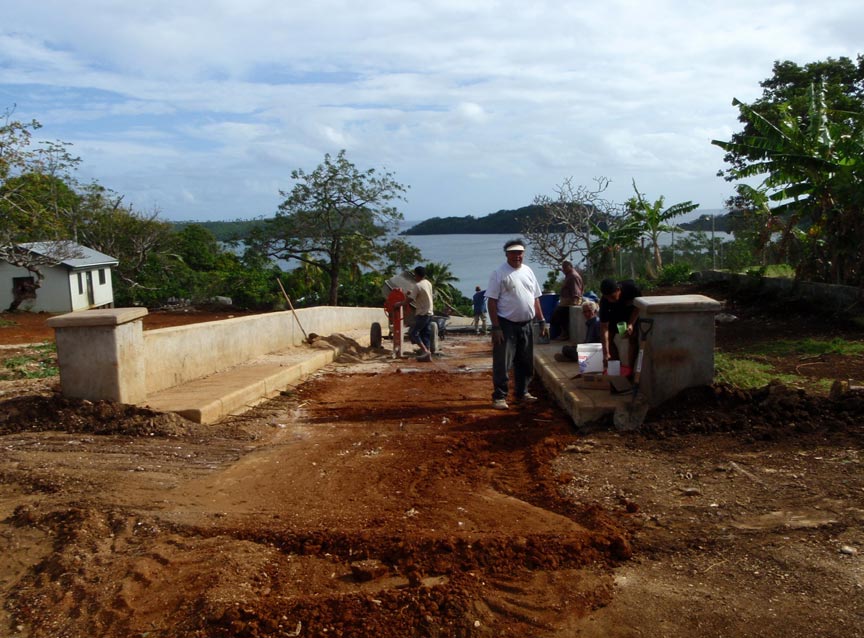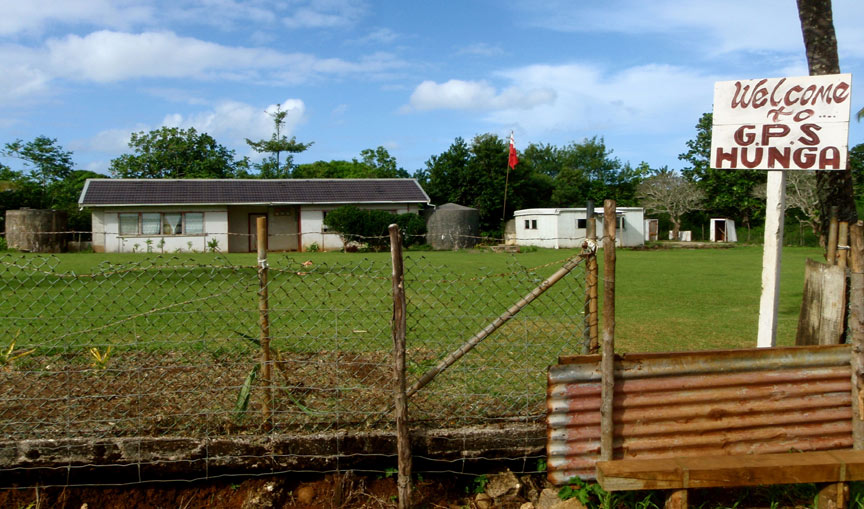Hunga Island, Vava'u, Tonga

Harmonie
Don and Anne Myers
Sun 21 Jun 2009 04:36
|
18:41.949S 174:08.096W
On June 8th we left Neiafu for the first time and
motored out with Storyteller to meet Lady Kay in the beautifully remote and
protected lagoon formed by Hunga, Kalau and Fofoa Islands, which is just a few
miles west of Neiafu. We knew the pass into Hunga Island lagoon was
extremely narrow, and at low tide the depth only 2 meters (we need at least
2.1). The guide books suggest the best time to go through the pass is at
or just after high tide when the water depth is at least 3 meters and the
current in the pass close to nil. We ignored this advice because it didn't
fit with our schedule and arrived outside the pass about half-way to low
tide. Hmmmm. The pass looked mighty small and the giant rock
sticking up on the left side made it look that much smaller. Don
and John decided the most prudent thing to do was to take Storyteller's dinghy
on a reconnaissance mission through the pass and back while Sue and I piloted
the boats around in circles outside the pass. The men returned after about
15 minutes and reported a thumb's up for a run at the pass.
We volunteered to go first. Up I went to the
bow to keep watch while Don steered us into the pass, all the while yelling
out depth and current information to keep me fully
informed. As long as we didn't look too closely at the bottom
looming up at us or the rocks on either side as we slowly motored through the
pass, we were fine. Once through, the depth went as low as 1 meter below
our keel as we skimmed over part of a reef, but since we really only
need about 1 inch below our keel, we were happy. Two more minutes and
it was all over as we hit deep water and headed toward where Lady Kay was
anchored alone in the lagoon.
Picture 1 - Motoring from Neiafu to Hunga
Island, we passed the now familiar parade of mushroom shaped islands topped
with palm trees that are unique to the Vava'u group of islands in Tonga.
This is one of those mushroom shaped islands. (At low tide it looks more
like a mushroom than it does in this picture taken at high
tide.)
Picture 2 - Hunga Island lagoon pass. We had
to go between the rock on the left and the hard place on the right to get
in. (This picture was taken from the bow of Storyteller in case you are
wondering why there are two very shiny anchors on the bow instead of the
single not-so-shiny anchor Harmonie has on its bow.)
Picture 3 - Harmonie and Storyteller at
anchor.
Picture 4 - The day after we arrived at Hunga
Island, John and Sue hosted a fishing party and the six of us (John, Sue,
Michael, Jackie, Don and myself) boarded Storyteller and motored out of the pass
for the day. Don and Michael brought all their fishing gear, and were
completely prepared to haul in, gut and cut up as many mahi-mahi as
possible. We put out three fishing lines, motored down one side of Hunga
Island, back up the same side, around the north end and back again with nothing
to show for it. Lunch time came and went. We continued to make plans for a
mahi-mahi dinner as the afternoon slipped by. We watched the horizon for
bird activity on the water and directed John to take us there. The birds
(and fish) cleared out every time we arrived in the area - no
doubt snickering about it as they went. We decided it was about time to
give it up when we saw bird activity nearby and John swung us directly through
it before they (and the fish) could get away. We watched from
Storyteller's tall fly bridge as a huge mahi-mahi dashed from where he was
swimming alongside the boat to swipe up Michael and Jackie's
fishing lure trailing off the back. A cry went up
across Storyteller's upper deck as the fish was hooked and tried to run off
with the line. 'Get the other lines in! Slow the boat down!
Get the gaff ready! Where's the fish vodka? Get Michael a
harness! It's a big one!' In the picture, Michael is reeling in the
fish as Don and Sue watch anxiously. In the end, Michael got the fish up
to the back of the boat where Don was positioned on the lower stern with the
gaff when, yup, you guessed it - the Pacific mahi-mahi performed the
now famous triple back-flip, double twist freedom move and just like that
flipped itself off the hook. Michael was none too pleased, but the fish
was more than likely giggling in a big way and pleased as punch as it
darted back to safety. So much for our big day of fishing. The
outing on Storyteller was a treat for us sailboaters though - fish or no
fish.
Picture 5 - The next day we stuck to landlubber
activities and found an abandoned citrus plantation / resort on Fofoa Island
where we stocked up on mandarin oranges and admired the hibiscus
flowers.
Picture 6 - The day after that we explored the
ocean side of Hunga Island at low tide and were treated to an nifty array
of coastal rock formations and rock pools. That's Sue admiring the
view.
Picture 7 - Two of our favorite blue starfish high
and dry at low tide.
Picture 8 - On our last day in the Hunga
lagoon, we explored Hunga Village, where they are building a road from
the main wharf to the town center. Aside from one small bull dozer brought
over from the US by the Tongan gentleman in the white t-shirt and visor who used
to work construction in California, they are building this concrete road
completely by hand. Funds for the materials were donated by
India ($2,000), but the men doing the work are doing it without
payment. We asked the bull dozer gentleman how far they planned to take
the road. 'The whole length of the island!' he said with a
proud grin. We wondered later why they would choose to do that when there
didn't seem to be any cars on the island (or any need
for them)?
Picture 9 - As the sign suggests, this
is the Hunga primary school (Government Primary School to be exact). If
kids go on to secondary school, they have to take a ferry to
Neiafu (and probably stay for the week with only weekends at
home).
Picture 10 - This is the backyard of one of the homes in Hunga village. Note
the outhouse in the right-hand corner.
Picture 11 - On June 13th we finally pulled
up anchor and left Hunga lagoon for Neiafu where we planned to stock up
and finalize plans to sail north to the fourth Tongan island group,
Niuatoputapu. More correctly, we attempted to pull up anchor. During
the five nights we stayed in Hunga lagoon, the wind changed directions several
times and tended to be gusty now and then when the strong trade winds
occasionally found their way into our snug anchorage. We knew our
anchor chain was hooked around coral because we could hear the chain grating
against the coral (a sound not unlike fingernails on a chalkboard) and because
we were not swinging in a proper arc around where we knew our anchor to
be. Instead we were moving this way and that around some other point,
presumably a lump of coral. We didn't realize how badly our chain was
wrapped until Don started pulling up the anchor chain using the windlass,
and after a tremendous BANG! this giant coral lump appeared along with our
chain. If you can't see it in the picture, the chain is wrapped completely
around the coral and itself. You can see the rest of the chain below the
coral leading down into the water. Wow. We've pulled up rocks
before, but this giant coral lump was a first for us. After using a rope
to take the weight off the chain, it didn't take Don long to wedge the chain off
the coral and return it to its home on the bottom 20 meters below. We
decided the coral lump was too big to keep as a souvenir (not to mention the
fact that Fiji, Vanuatu, New Caledonia and Australian quarantine or customs
might have a problem with us carting around a giant lump of Tongan coral in our
boat). After that the rest of the chain and anchor came up without a hitch
and we were on our way.
More Vava'u adventures later.
Anne
|










